Development of Equivalent Beam Model of High Burnup Spent Nuclear Fuel Rods under Lateral Impact Loading
Abstract
1. Introduction
2. Material Properties of Target Fuel Rod
2.1. Reference Fuel
2.2. Mechanical Properties of Irradiated Fuel Rod
3. Equivalent Beam Model of Spent Nuclear Fuel Rod
3.1. Objective of Model Simplification
3.2. Detailed Finite Element Model of Fuel Rod Segment
3.3. Loading, Boundary Conditions for Static Analyses of Fuel Rod Segments
3.4. Results of Static Analyses for the Fuel Rod Segments
3.5. Calibration of Material and Section Parameters of Simplified Beam Model
3.6. Applicability of Simplified Models in Analyses of Fuel Rods with Various Lengths
4. Applicability of Developed Models in Dynamic Impact Simulations
4.1. Models for Impact Simulation and Impact Conditions
4.2. Results and Discussions
5. Discussions and Conclusions
- -
- In this work, only the horizontal or lateral loading cases are considered. It is known that the horizontal and vertical drops are two representative drop orientations of the SNF transportation cask and that the horizontal drop is more bounding than the vertical one [14,15]. Thus, the use of the developed models in other drop orientations would produce rather conservative results. The applicability of the proposed method and models in other drop orientations needs to be carefully investigated in order to demonstrate the usefulness of the current work for SNF transportation applications. This is the topic of the authors’ future research.
- -
- The calibration procedure is based on an assumption that the fuel rod failure can be predicted via the plastic strain calculated by the curvature rather than via the local strain components. The validity of this assumption cannot be checked right away due to the lack of supporting data. However, the procedure proposed in this work can be used with minimal modifications with a different measure of fuel rod failure.
- -
- In this work, two extreme cases of interfacial conditions were considered. The actual behavior of the interfacial bonding might be intermediate; the bond may break during the loading processes. It is expected that the results of this study provide the bounds of the effective properties of the high burnup fuel rods.
- -
- Although the proposed simplified models show perfect agreements with the detailed models in predicting the maximum displacement and plastic strain in static analyses, they show considerable discrepancies in dynamic impact simulations. To overcome this issue, a compensating factor can be introduced for the accurate prediction of fuel rod failure. This is a topic which needs further investigations.
- -
- There exist many types of uncertainties in the properties and geometries of SNF rods, and they need to be adequately considered for a more realistic and reliable prediction of fuel rod behavior. The approach proposed in this work is purely deterministic but can be combined with well-established uncertainty propagation methods in the literature to quantify the uncertainties in the calibrated model parameters and the resulting behavior of SNF rods and to find their error bounds.
Author Contributions
Funding
Acknowledgments
Conflicts of Interest
References
- Ojovan, M.I.; Lee, W.E.; Kalmykov, S.N. An Introduction to Nuclear Waste Immobilization; Elsevier: Amsterdam, The Netherlands, 2019. [Google Scholar]
- U.S. Nuclear Regulatory Commission. Licensing Requirements for the Independent Storage of Spent Nuclear Fuel, High-level Radioactive Waste, and Reactor-related Greater than Class C Waste, Rules and Regulations, Title 10, Part 72; US NRC: Washington, DC, USA, 2010.
- U.S. Nuclear Regulatory Commission. Packaging and Transportation of Radioactive Material, Rules and Regulations, Title 10, Part 71; US NRC: Washington, DC, USA, 2009.
- IAEA Safety Standard. Regulations for the Safe Transport of Radioactive Material, 2012 ed.; Specific Safety Requirements No. SSR-6; IAEA: Vienna, Austria, 2012. [Google Scholar]
- U.S. Nuclear Regulatory Commission. Cladding Considerations for the Transportation and Storage of Spent Fuel, Interim Staff Guidance-11 Rev. 3; US NRC: Washington, DC, USA, 2003.
- Geelhood, K.J.; Beyer, C.E.; Luscher, W.G. PNNL Stress/Strain Correlation for Zircaloy (PNNL-17700); Pacific Northwest National Laboratory (PNNL): Richland, WA, USA, 2008. [Google Scholar]
- Adkins, H.; Geelhood, K.; Koeppel, B.; Coleman, J.; Bignell, J.; Flores, G.; Wang, J.A.; Sanborn, S.; Spears, R.; Klymyshyn, N. Used Fuel Disposition Campaign, Used Nuclear Fuel Loading and Structural Performance under Normal Conditions of Transport—Demonstration of Approach and Results on Used Fuel Performance Characterization (FCRD-UFD-2013-000325); U.S. Department of Energy: Washington, DC, USA, 2013.
- Cheon, J.S.; Lee, B.H.; Koo, Y.H.; Oh, J.Y.; Sohn, D.S. Evaluation of a pellet-clad mechanical interaction in mixed oxide fuels during power transients by using axisymmetric finite element modeling. Nucl. Eng. Des. 2004, 231, 39–50. [Google Scholar] [CrossRef]
- Marchal, N.; Campos, C.; Garnier, C. Finite element simulation of Pellet-Cladding Interaction (PCI) in nuclear fuel rods. Comput. Mater. Sci. 2009, 45, 821–826. [Google Scholar] [CrossRef]
- Kim, H.C.; Seo, S.K.; Lee, S.U.; Yang, Y.S. Development of NUFORM3D module with FRAPCON3. 4 for simulation of pellet-cladding mechanical interaction. Nucl. Eng. Des. 2017, 318, 61–71. [Google Scholar] [CrossRef]
- Jiang, H.; Wang, J.A.; Wang, H. The impact of interface bonding efficiency on high-burnup spent nuclear fuel dynamic performance. Nucl. Eng. Des. 2016, 309, 40–52. [Google Scholar] [CrossRef]
- Wang, J.A.; Wang, H.; Jiang, H.; Bevard, B. High burn-up spent nuclear fuel transport reliability investigation. Nucl. Eng. Des. 2018, 330, 497–515. [Google Scholar] [CrossRef]
- Almomani, B.; Jang, D.; Lee, S. Structural integrity of a high-burnup spent fuel rod under drop impact considering pellet-clad interfacial bonding influence. Nucl. Eng. Des. 2018, 337, 324–340. [Google Scholar] [CrossRef]
- Almomani, B.; Kim, S.; Jang, D.; Lee, S. Parametric study on the structural response of a high burnup spent nuclear fuel rod under drop impact considering post-irradiated fuel conditions. Nucl. Eng. Technol. 2019, in press. [Google Scholar] [CrossRef]
- Chun, R.; Witte, M.; Schwartz, M. Dynamic Impact Effects on Spent Fuel Assemblies (UCID-21246); Lawrence Livermore National Laboratory: Livermore, CA, USA, 1987. [Google Scholar]
- Sanders, T.L.; Seager, K.D.; Rashid, Y.R.; Barrett, P.R.; Malinauskas, A.P.; Einziger, R.E.; Jordan, H.; Duffey, T.A.; Sutherland, S.H.; Reardon, P.C. A Method for Determining the Spent-fuel Contribution to Transport Cask Containment Requirements (SAND90-2406); Sandia National Labs: Albuquerque, NM, USA, 1992. [Google Scholar]
- U.S. Nuclear Regulatory Commission. Spent Fuel Transportation Risk Assessment (NUREG-2125); US NRC: Washington, DC, USA, 2014.
- Kalan, R.J.; Clutz, C.J.R.; Ammerman, D.J. Analysis of a 17 × 17 Pressurized Water Reactor (PWR) Fuel Assembly; Letter Report to the U.S. Department of Energy; US DOE: Washington, DC, USA, 2005.
- Bjorkman, G.S. The buckling of fuel rods under inertia loading. Packag. Transp. Storage Secur. Radioact. Mater. 2010, 21, 165–168. [Google Scholar] [CrossRef]
- Ballheimer, V.; Wille, F.; Droste, B. Mechanical safety analysis for high burn-up spent fuel assemblies under accident transport conditions. Packag. Transp. Storage Secur. Radioact. Mater. 2010, 21, 212–217. [Google Scholar] [CrossRef]
- James, R.; Rashid, J.; Dunham, R.; Zhang, L. Spent Fuel Transportation Applications: Fuel Rod Failure Evaluation under Simulated Cask Side Drop Conditions (EPRI 1009929); EPRI: Palo Alto, CA, USA, 2005. [Google Scholar]
- Rashid, J.; Dunham, R.; Wong, F.; James, R. Spent Fuel Transportation Applications: Global Forces Acting on Spent Fuel Rods and Deformation Patterns Resulting from Transportation Accidents (EPRI 1011817); EPRI: Palo Alto, CA, USA, 2005. [Google Scholar]
- Rashid, J. Spent Fuel Transportation Applications—Assessment of Cladding Performance: A Synthesis Report (EPRI 1-15048); EPRI: Palo Alto, CA, USA, 2007. [Google Scholar]
- Lee, S.; Kim, S. Simplified beam model of high burnup spent fuel rod under lateral load considering pellet-clad interfacial bonding influence. Nucl. Eng. Technol. 2019, 51, 1333–1344. [Google Scholar] [CrossRef]
- U.S. Nuclear Regulatory Commission. A Pilot Probabilistic Risk Assessment of a Dry Cask Storage System at a Nuclear Power Plant (NUREG-1864); US NRC: Washington, DC, USA, 2007.
- Michael, S. ABAQUS/Standard User’s Manual, Version 6.9; Dassault Systèmes Simulia Corp: Providence, RI, USA, 2009. [Google Scholar]
- Aguiar, H.; Ingber, L.; Petraglia, A.; Rembold, M.; Augusta, M. Adaptive Simulated Annealing. In Stochastic Global Optimization and Its Applications with Fuzzy Adaptive Simulated Annealing; Intelligent Systems Reference Library Volume 35; Springer: Berlin/Heidelberg, Germany, 2012. [Google Scholar]
- Velden, A.; Koch, P. Isight Design Optimization Methodologies. In ASM Handbook Volume 22B, Metals Process Simulation; Furrer, D.U., Semiatin, S.L., Eds.; ASM International: Geauga County, OH, USA, 2010. [Google Scholar]



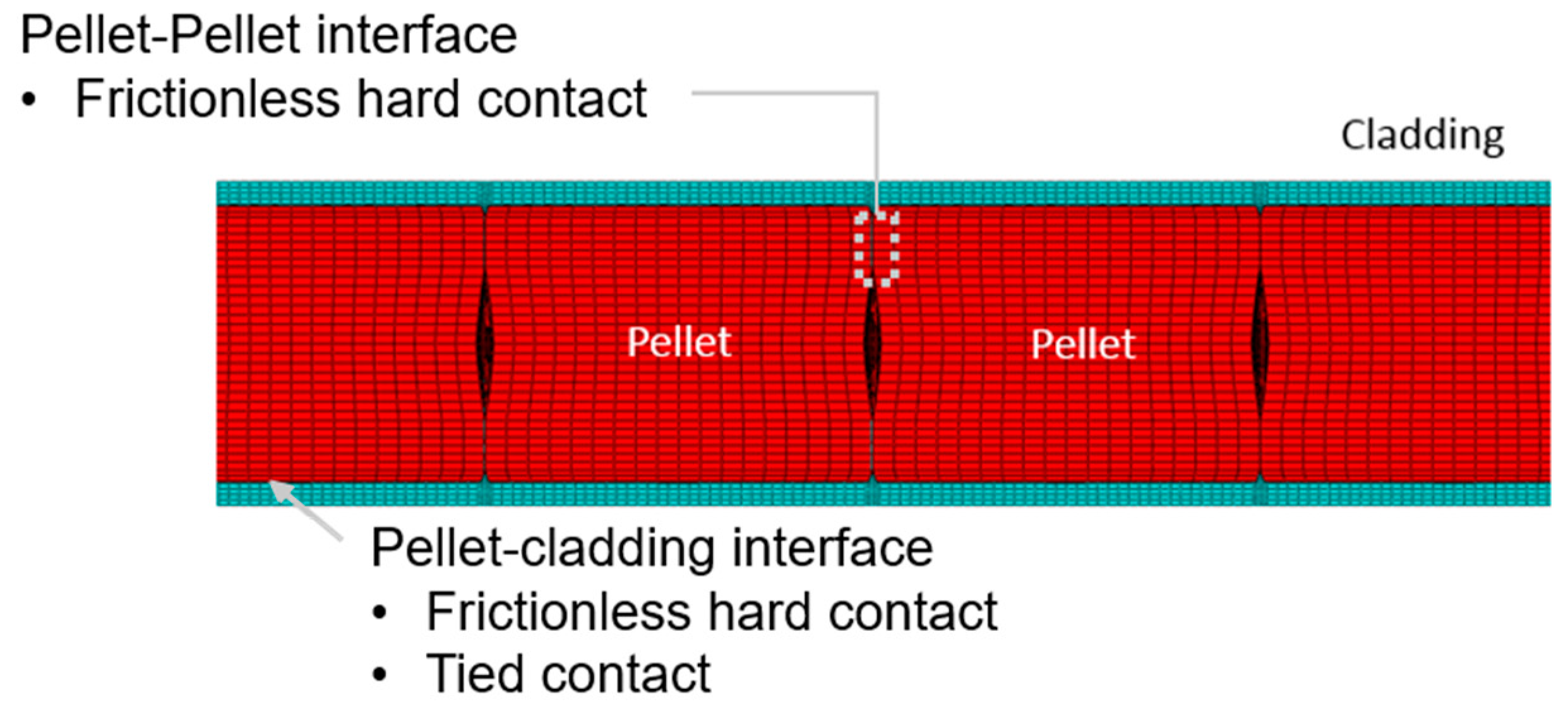




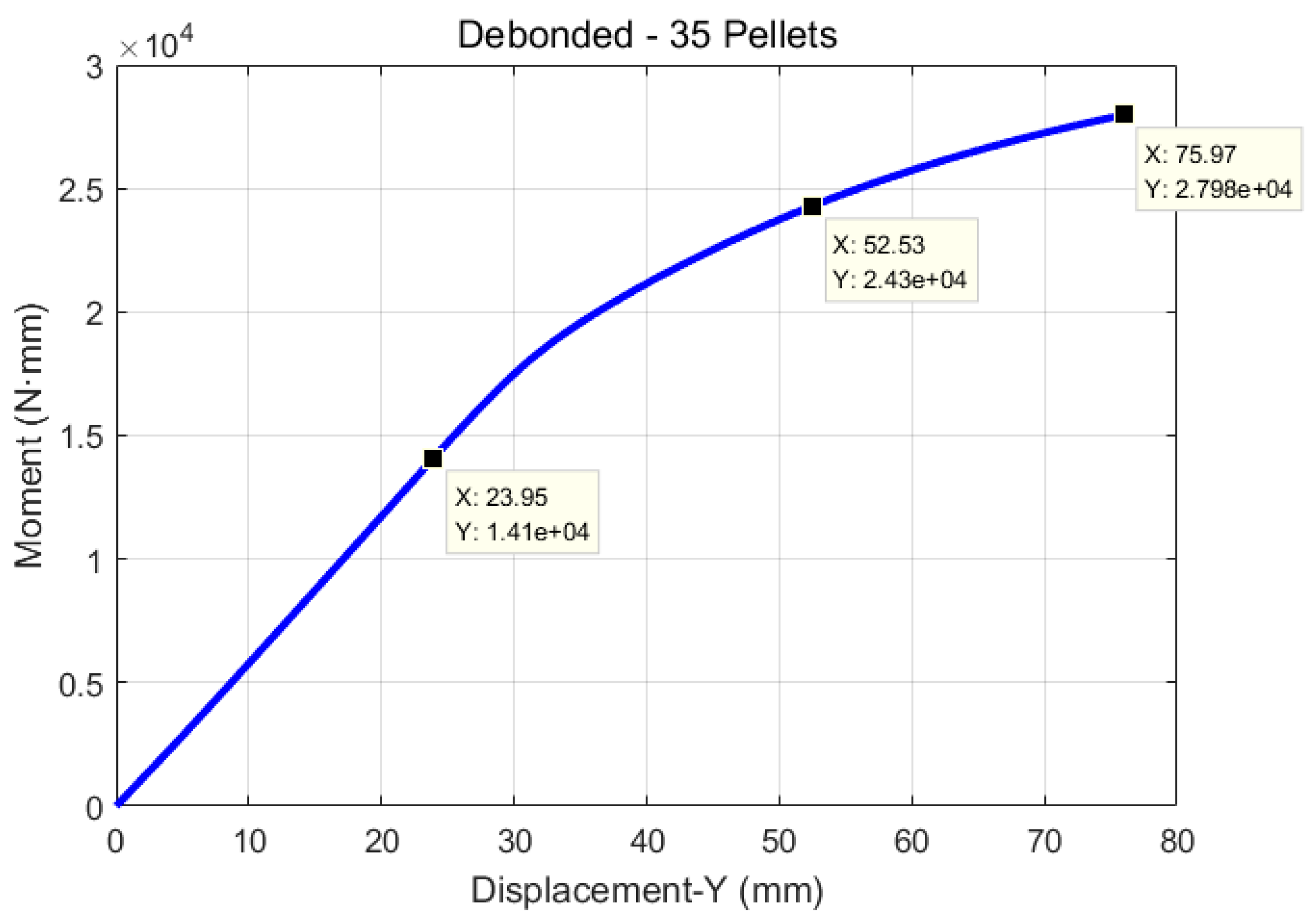

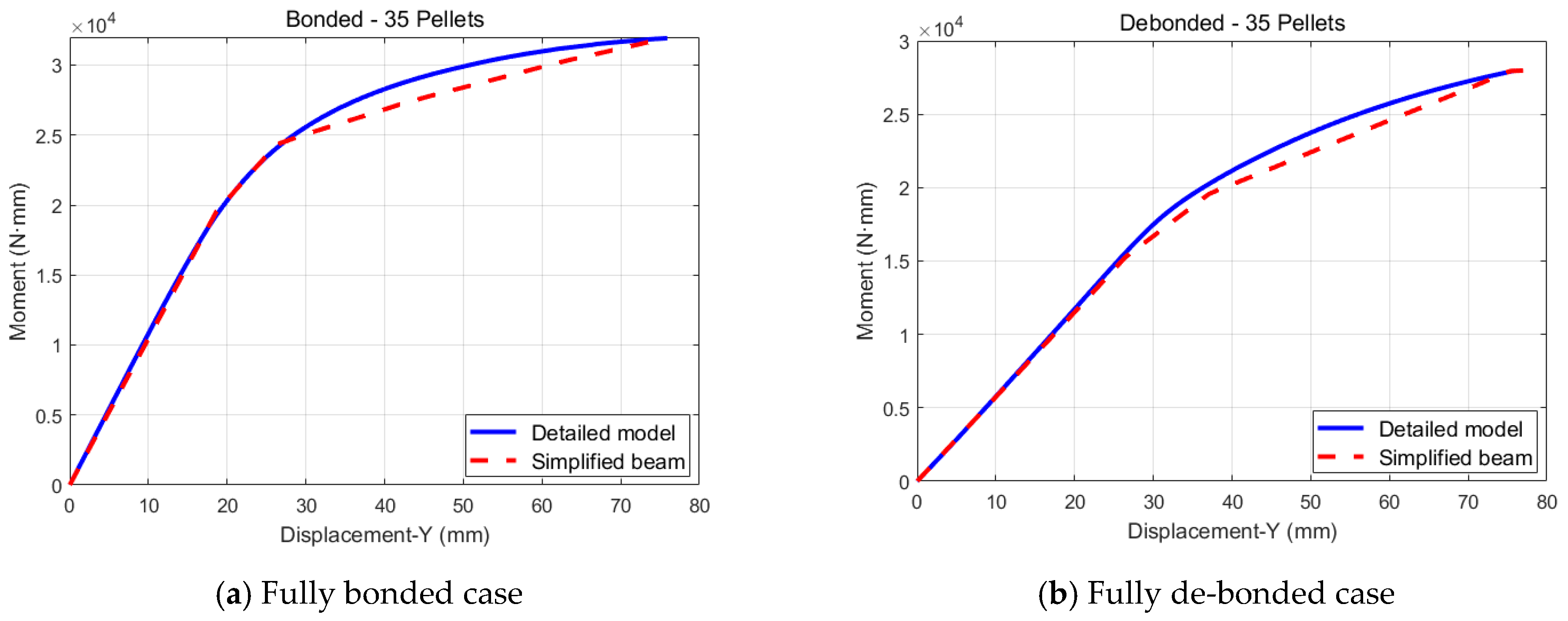


| Parameter | Value |
|---|---|
| Cladding length (L) | 4.094 m |
| Outer diameter of cladding (OD) (ro) | 4.75 mm |
| Inner diameter of cladding (ID) (ri) | 4.178 mm |
| Diametral gap | 165 |
| Distance between two sequent spacer grids | 396.9 mm |
| Area moment of inertia for the cladding (Ic) | 160.508 mm4 |
| Area moment of inertia for the pellet (Ip) | 239.291 mm4 |
| Pellet diameter | 8.191 mm |
| Pellet length | 11.34 mm |
| Number of pellets in full fuel rod | 350 |
| Pellet hollow depth | 0.3 mm |
| Pellet hollow radius | 14 mm |
| Pellet hollow apparent radius | 2.95 mm |
| Pellet edge chamfer radius | 3.55 mm |
| Pellet edge chamfer depth | 0.16 mm |
| Gap with adjacent pellets | No gap |
| Total weight of single rod (W) | 2.58 kg |
| Fraction of theoretical density of UO2 (%TD) | 95% |
| Assembly weight | 639 kg |
| Number of rods | 236 |
| Number of spacer grids | 12 |
| Parameter | Value |
|---|---|
| Temperature (T) | 300 °C |
| Neutron fluence (Φ) | 11.4 × 1025 n/m2 |
| Burnup (Bu) | 60 GWd/MTU |
| Total hydrogen concentration (Htot) | 352 ppm |
| Parameters | Mechanical Properties |
|---|---|
| 1. Zircaloy cladding (SRA Zry-4) | |
| a. Mass density () | 6590 kg/m3 |
| b. Modulus of elasticity (E) | 75.22 GPa |
| c. Strength coefficient (K) | 14.43 GPa |
| d. Strain hardening exponent (n) | 0.159 |
| e. Strain rate exponent (m) | 0.015 |
| f. Shear modulus (G) | 28.28 GPa |
| g. Poisson’s ratio (v) | 0.33 |
| h. Uniform plastic elongation (UE) | 0.022 |
| i. Yield strength () | 644.79 MPa |
| j. Ultimate tensile strength () | 788.68 MPa |
| 2. Fuel (Uranium dioxide (UO2)) | |
| a. Mass density () | 10,440 kg/m3 |
| b. Modulus of elasticity (E) | 168.3 GPa |
| c. Poisson’s ratio (v) * | 0.32 |
| d. Yield strength () * | 2146 MPa |
| Case | Optimal Parameter Values | Critical Moment | (dev. %) | (dev. %) | (dev. %) | Density (kg/m3) | ||
|---|---|---|---|---|---|---|---|---|
| T (mm) | n | K (MPa) | ||||||
| Fully bonded | 0.73 | 0.043 | 2000.0 | 31.9 N⋅m | 18.17 (0.0) | 56.88 (18.5) | 75.71 (0.3) | 1653.39 |
| Fully de-bonded | 2.04 | 0.629 | 5101.4 | 28.0 N⋅m | 24.40 (1.8) | 58.73 (10.6) | 76.98 (1.3) | 694.84 |
| Cases | Number of Pellets | Length (mm) | Critical Moment | Model | Displacement | Plastic Strain | ||
|---|---|---|---|---|---|---|---|---|
| Value (mm) | Dev. (%) | Value (%) | Dev. (%) | |||||
| Bonded | ||||||||
| 1 | 15 | 170.1 | 31,919 | Detailed | 15.27 | 1.2 | 1.0 | 0 |
| Simplified | 15.08 | 1.0 | ||||||
| 2 | 20 | 226.8 | Detailed | 25.27 | 1.3 | 1.0 | 0 | |
| Simplified | 25.60 | 1.0 | ||||||
| 3 | 25 | 283.5 | Detailed | 40.12 | 0.1 | 1.0 | 0 | |
| Simplified | 40.09 | 1.0 | ||||||
| 4 | 30 | 340.2 | Detailed | 56.64 | 0.1 | 1.0 | 0 | |
| Simplified | 56.67 | 1.0 | ||||||
| 5 | 35 (reference) | 396.9 | Detailed | 75.91 | 0.3 | 1.0 | 0 | |
| Simplified | 75.71 | 1.0 | ||||||
| De-bonded | ||||||||
| 1 | 15 | 170.1 | 27,975 | Detailed | 15.17 | 0.9 | 1.0 | 0 |
| Simplified | 15.03 | 1.0 | ||||||
| 2 | 20 | 226.8 | Detailed | 26.27 | 0.7 | 1.0 | 0 | |
| Simplified | 26.08 | 1.0 | ||||||
| 3 | 25 | 283.5 | Detailed | 40.23 | 0.7 | 1.0 | 0 | |
| Simplified | 39.96 | 1.0 | ||||||
| 4 | 30 | 340.2 | Detailed | 56.85 | 0.6 | 1.0 | 0 | |
| Simplified | 56.49 | 1.0 | ||||||
| 5 | 35 (reference) | 396.9 | Detailed | 76.98 | 1.3 | 1.0 | 0 | |
| Simplified | 75.97 | 1.0 | ||||||
| No. | Drop Height (m) | Model | Max. Displacement | Plastic Bending Strain | ||
|---|---|---|---|---|---|---|
| Value (mm) | Dev. (%) | Value (%) | Dev. (%) | |||
| 1 | 0.5 | Detailed | 2.85 | 2.3 | 0.24 | 0.0 |
| Simplified | 2.91 | 0.24 | ||||
| 2 | 1.0 | Detailed | 4.08 | 1.0 | 0.27 | 7.4 |
| Simplified | 4.12 | 0.25 | ||||
| 3 | 1.5 | Detailed | 5.03 | 0.0 | 0.30 | 6.0 |
| Simplified | 5.03 | 0.28 | ||||
| 4 | 2.0 | Detailed | 5.88 | 1.2 | 0.52 | 23.3 |
| Simplified | 5.81 | 0.40 | ||||
| 5 | 2.5 | Detailed | 6.57 | 2.0 | 0.73 | 12.1 |
| Simplified | 6.44 | 0.64 | ||||
| 6 | 3.0 | Detailed | 7.26 | 4.1 | 0.99 | 36.4 |
| Simplified | 6.96 | 0.63 | ||||
| 7 | 3.05 (Critical) | Detailed | 7.32 | 1.0 | 1.00 | 27.0 |
| Simplified | 7.40 | 0.73 | ||||
| 8 | 3.5 | Detailed | 7.72 | 2.8 | 1.11 | 27.6 |
| Simplified | 7.50 | 0.80 | ||||
| 9 | 4.0 | Detailed | 8.26 | 4.4 | 1.19 | 37.8 |
| Simplified | 7.90 | 0.74 | ||||
| No. | Drop Height (m) | Model | Max. Displacement | Plastic Bending Strain | ||
|---|---|---|---|---|---|---|
| Value (mm) | Dev. (%) | Value (%) | Dev. (%) | |||
| 1 | 0.5 | Detailed | 4.12 | 10.1 | 0.00 | 5 |
| Simplified | 3.70 | 0.05 | ||||
| 2 | 1.0 | Detailed | 5.78 | 15.0 | 0.66 | 81.4 |
| Simplified | 4.91 | 0.12 | ||||
| 3 | 1.5 | Detailed | 6.93 | 16.8 | 0.75 | 55.0 |
| Simplified | 5.77 | 0.34 | ||||
| 4 | 2.0 | Detailed | 7.83 | 16.5 | 0.85 | 35.4 |
| Simplified | 6.54 | 0.55 | ||||
| 5 | 2.5 | Detailed | 8.44 | 16.7 | 0.96 | 30.7 |
| Simplified | 7.03 | 0.66 | ||||
| 6 | 2.63 (Critical) | Detailed | 8.62 | 6.0 | 1.03 | 16.3 |
| Simplified | 8.11 | 0.86 | ||||
| 7 | 3.0 | Detailed | 8.93 | 17.5 | 1.12 | 35.0 |
| Simplified | 7.36 | 0.73 | ||||
| 8 | 3.5 | Detailed | 9.51 | 17.0 | 1.33 | 34.3 |
| Simplified | 7.89 | 0.87 | ||||
| 9 | 4.0 | Detailed | 9.86 | 17.9 | 1.42 | 39.4 |
| Simplified | 8.11 | 0.86 | ||||
| Drop Height (m) | Fully Bonded Fuel Rod | Fully De-Bonded Fuel Rod |
|---|---|---|
| 0.5 |  | 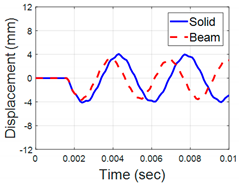 |
| 1.0 | 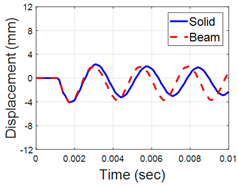 | 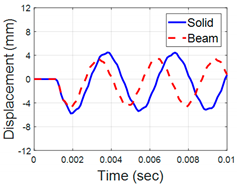 |
| 2.0 | 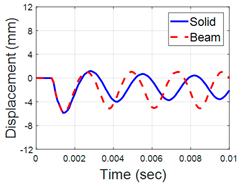 | 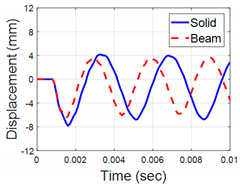 |
| Critical (bonded: 3.05 de-bonded: 2.63) |  | 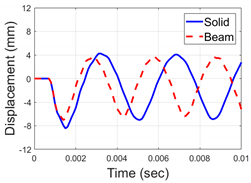 |
| 4.0 | 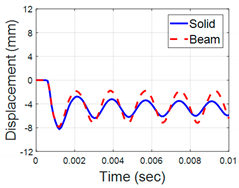 | 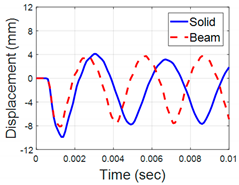 |
© 2020 by the authors. Licensee MDPI, Basel, Switzerland. This article is an open access article distributed under the terms and conditions of the Creative Commons Attribution (CC BY) license (http://creativecommons.org/licenses/by/4.0/).
Share and Cite
Lee, S.; Kim, S. Development of Equivalent Beam Model of High Burnup Spent Nuclear Fuel Rods under Lateral Impact Loading. Metals 2020, 10, 470. https://doi.org/10.3390/met10040470
Lee S, Kim S. Development of Equivalent Beam Model of High Burnup Spent Nuclear Fuel Rods under Lateral Impact Loading. Metals. 2020; 10(4):470. https://doi.org/10.3390/met10040470
Chicago/Turabian StyleLee, Sanghoon, and Seyeon Kim. 2020. "Development of Equivalent Beam Model of High Burnup Spent Nuclear Fuel Rods under Lateral Impact Loading" Metals 10, no. 4: 470. https://doi.org/10.3390/met10040470
APA StyleLee, S., & Kim, S. (2020). Development of Equivalent Beam Model of High Burnup Spent Nuclear Fuel Rods under Lateral Impact Loading. Metals, 10(4), 470. https://doi.org/10.3390/met10040470




